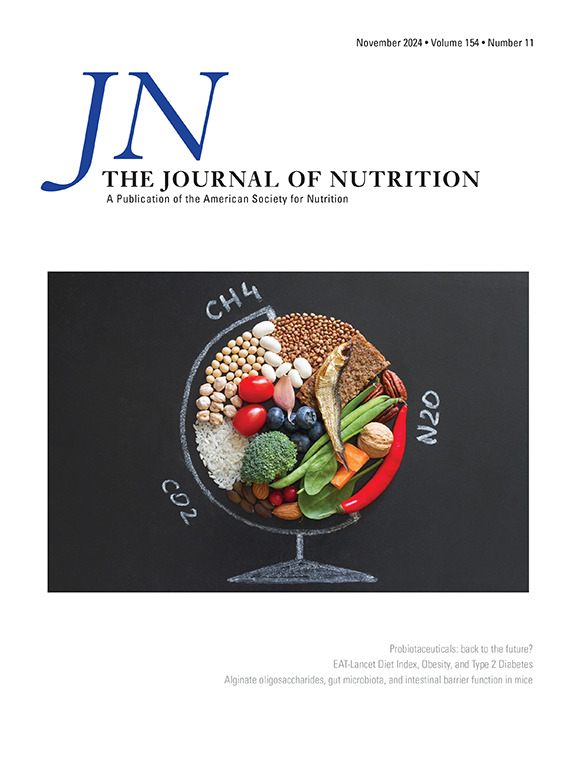印度南部妇女及其家庭对四倍强化食盐接受度的随机交叉试验。
IF 3.7
3区 医学
Q2 NUTRITION & DIETETICS
引用次数: 0
摘要
背景:双强化盐(DFS;铁、碘)在随机试验中改善了铁的状况,并被纳入印度的社会安全网计划,这表明有机会解决其他微量营养素缺乏的问题:采用随机交叉试验设计和三角测试,评估妇女及其家庭对四重强化盐(QFS;铁、碘、叶酸、维生素 B12)的接受程度:在为期三周的随机交叉试验中,18-49 岁的女性(人数=77)及其家庭被随机分配接受 QFS 或 DFS(第 1 周:QFS/DFS,第 2 周:碘盐,第 3 周:DFS/QFS)。每周,参与者填写一份 9 分享乐主义问卷(1 分=非常不喜欢到 9 分=非常喜欢),对干预措施的五个感官领域(颜色、气味、味道、质地、总体可接受性)进行评估,并使用电子秤称量剩余食盐的重量。在妇女中进行了三角测试,以评估使用标准化食谱制作的米饭菜肴中食用盐的感官辨别力。采用混合模型来研究享乐评价和盐的使用;盐的类型、顺序和时间作为固定效应,家庭作为随机效应。在三角测试中使用二项式检验来评估盐类的感官辨别能力:五个感官领域中的大多数感官评分的平均值都≥7(喜欢程度一般),且不因盐的类型而异(总体可接受性平均值 [SD]: QFS: 7.8 [0.7] vs. DFS: 7.7 [1.2]; p=0.68)。家庭用盐量(称重)不因盐的种类而异。在为期 3 周的干预期间,称重后的食盐用量和享乐性评分均显著增加,这表明期间效应与食盐类型或顺序无关。在三角测试中,用合格食盐、普通食盐或加碘盐制备的大米样品无法区分:结论:根据个人享乐评价和家庭用盐量,合格食盐的可接受性很高。使用DFS、QFS和加碘盐烹制的米饭菜肴没有区别。研究结果为在该人群中设计 QFS 随机试验提供了依据:注册号:NCT03853304 和 REF/2019/03/024479。本文章由计算机程序翻译,如有差异,请以英文原文为准。
A Randomized Crossover Trial of Acceptability of Quadruple-Fortified Salt in Women and their Households in Southern India
Background
Double-fortified salt (DFS; iron, iodine) improved iron status in randomized trials and was incorporated into India’s social safety net programs, suggesting opportunities to address other micronutrient deficiencies.
Objectives
To evaluate the acceptability of quadruple-fortified salt (QFS; iron, iodine, folic acid, and vitamin B12) in women and their households, using a randomized crossover trial design and triangle tests.
Methods
Women 18–49 y (n = 77) and their households were randomly assigned to receive QFS or DFS in a randomized crossover design over a 3-wk period (week 1: QFS/DFS, week 2: iodized salt, week 3: DFS/QFS). Each week, participants completed a 9-point hedonic questionnaire (1 = dislike extremely to 9 = like extremely) to evaluate 5 sensory domains (color, odor, taste, texture, and overall acceptability) of the intervention, and the remaining salt was weighed using a digital scale. Triangle tests were conducted among women to evaluate sensory discrimination of salt consumed in rice dishes prepared using standardized recipes. Mixed models were used to examine hedonic ratings and salt use; salt type, sequence, and period were included as fixed effects, and household was included as a random effect. Binomial tests were used to evaluate sensory discrimination of salt type in triangle tests.
Results
Mean hedonic ratings for most of the 5 sensory domains were ≥7 (like moderately) and did not differ by salt type [overall acceptability mean (SD): QFS: 7.8 (0.7) compared with DFS: 7.7 (1.2); P = 0.68]. Household salt use (weighed) did not differ by salt type. During the 3-wk intervention period, weighed salt use and hedonic ratings significantly increased, indicating a period effect independent of salt type or sequence. In triangle tests, rice samples prepared with QFS, DFS, or iodized salt were not distinguishable.
Conclusions
Acceptability of QFS was high, based on individual hedonic ratings and weighed household salt use. Rice dishes prepared with DFS, QFS, and iodized salt were not distinguishable. Findings informed the design of a randomized trial of QFS in this population.
This trial was registered at clinicaltrials.gov as NCT03853304 and CTRI/2024/04/066208.
求助全文
通过发布文献求助,成功后即可免费获取论文全文。
去求助
来源期刊

Journal of Nutrition
医学-营养学
CiteScore
7.60
自引率
4.80%
发文量
260
审稿时长
39 days
期刊介绍:
The Journal of Nutrition (JN/J Nutr) publishes peer-reviewed original research papers covering all aspects of experimental nutrition in humans and other animal species; special articles such as reviews and biographies of prominent nutrition scientists; and issues, opinions, and commentaries on controversial issues in nutrition. Supplements are frequently published to provide extended discussion of topics of special interest.
 求助内容:
求助内容: 应助结果提醒方式:
应助结果提醒方式:


